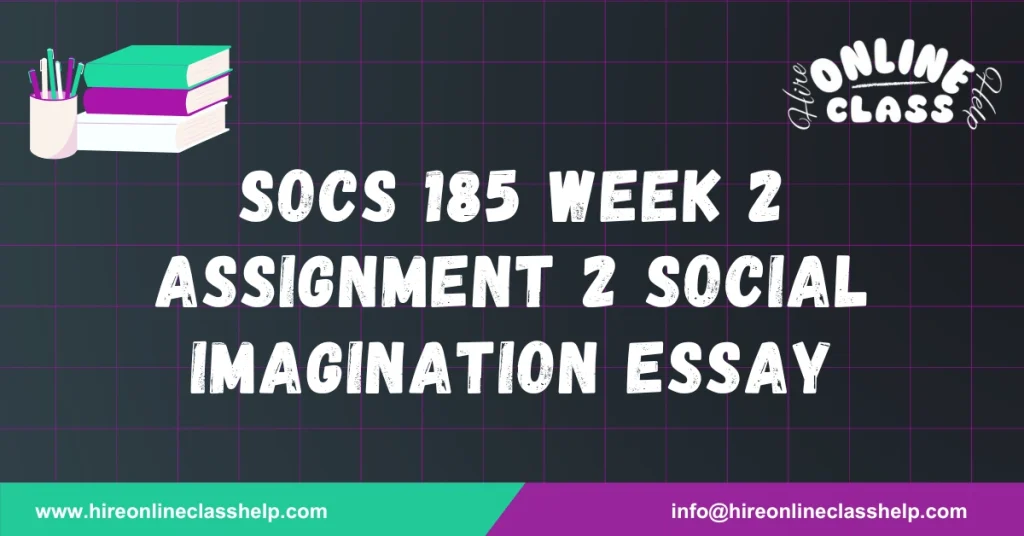






Name
Chamberlain University
SOCS-185 Culture & Society
Prof. Name
Date
Sociological imagination is a concept that bridges the gap between personal experiences and broader societal forces. Coined by renowned sociologist C. Wright Mills, sociological imagination allows individuals to recognize the connection between their personal struggles and larger public issues. By using this perspective, people can understand how societal factors influence individual behavior, decisions, and life outcomes.
Sociological imagination refers to the awareness of the intricate relationship between an individual’s personal experiences and the broader social structures that shape their life. C. Wright Mills, the author of The Sociological Imagination, emphasized how this concept enables us to grasp “history and biography and the relationship between the two within society.” Essentially, sociological imagination allows people to understand how their personal challenges are intertwined with public issues influenced by historical and social contexts.
The concept of sociological imagination can be applied to a variety of real-world issues, such as addiction, homelessness, obesity, domestic violence, and even veteran homelessness. These are not just personal struggles, but issues that arise due to broader social forces such as economic inequality, lack of social support, or inadequate healthcare. For example, addiction may seem like a personal failing, but when viewed through the lens of sociological imagination, it can be seen as a result of poverty, social isolation, or mental health issues.
Sociological imagination helps people understand why individuals face particular struggles and what societal forces contribute to their situation. This understanding helps people not only sympathize with those in difficult circumstances but also recognize the role society plays in shaping these outcomes.
A common example of sociological imagination at work is in understanding addiction. Addiction can stem from multiple factors such as poverty, mental health struggles, socioeconomic status, or depression. Those who have never experienced addiction may find it difficult to comprehend how deeply this illness affects individuals and those around them. However, by employing sociological imagination, one can recognize how these social and economic forces shape a person’s vulnerability to addiction.
For example, my personal experience with addiction in my family serves as a stark reminder of the complexities involved. My brother’s battle with drug addiction, which tragically ended with his passing due to an overdose, left our family grappling with questions. How did two siblings raised in the same environment end up on such different paths? Sociological imagination allowed me to look beyond the surface and consider the broader social and environmental factors that may have shaped my brother’s choices and struggles. This perspective offered clarity and helped me reflect on how societal forces such as mental health, peer pressure, and economic challenges could have influenced his life trajectory.
The link between addiction and suicide is often overlooked, but they frequently go hand in hand. Addiction, particularly when left untreated, can lead to feelings of hopelessness, isolation, and depression—all risk factors for suicide. Sociological studies on suicide have shown that addiction often intensifies these feelings, creating a dangerous cycle that can lead to tragic outcomes.
In my own experience, addiction led to my brother’s untimely death, and it made me reflect deeply on the role of sociological imagination in understanding such tragedies. According to a study by the Center for Suicide Prevention, one suicide can impact up to 135 people, highlighting the far-reaching consequences of such events. By applying sociological imagination, we can better understand how broader societal forces—such as economic pressures, social expectations, and mental health challenges—contribute to both addiction and suicide.
Sociological imagination can also be used to analyze global trends in suicide. For example, a study on suicide rates among young people in India highlighted how economic growth and increasing job pressures contributed to a rise in suicide rates. As India’s economy boomed, individuals faced heightened expectations for success, leading to increased anxiety and stress. While we often associate suicide with poverty, this study revealed that economic prosperity can also create immense pressures that drive individuals to despair.
Sociological imagination allows us to see beyond personal struggles and consider how societal changes—such as economic booms or downturns—can impact mental health. This understanding is crucial for addressing the root causes of mental health crises and providing effective support for individuals in distress.
Sociological imagination isn’t just a tool for understanding; it can also foster empathy and inspire social change. When we use sociological imagination to analyze issues like addiction, homelessness, or domestic violence, we begin to see the individuals behind these struggles in a new light. Instead of blaming people for their circumstances, we can recognize the societal forces at play and work toward addressing the root causes of these issues.
By becoming more aware of how societal forces shape our lives, we can change how we interact with others, provide support to those in need, and use our influence to advocate for systemic change. Sociological imagination enables us to move beyond judgment and toward understanding, helping us create a more compassionate and just society.
Sociological imagination offers a powerful lens through which to view the world. It helps us see the connections between individual experiences and broader social issues, enabling us to better understand why people face the challenges they do. Whether it’s addiction, homelessness, or mental health struggles, sociological imagination allows us to empathize with others and recognize the role that societal forces play in shaping their lives.
In a world filled with complex social issues, the ability to think critically and apply sociological imagination is more important than ever. By doing so, we can work toward a more equitable and compassionate society—one that supports individuals in overcoming their struggles and empowers communities to address the social forces that contribute to those challenges.